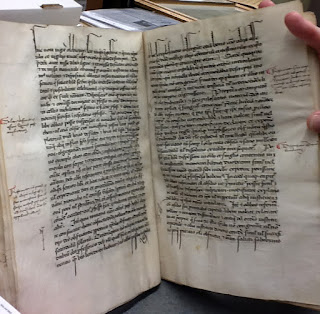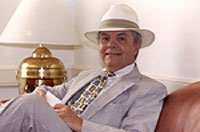Tuesday, September 10, 2013
Recently, I received an inquiry about faculty member Robbie Robinson as the result of a gift received by Western Reserve Academy.
Irving L."Robbie" Robinson was on the WRA faculty as a master of French from 1953 to 1967, and left the same year that Headmaster John W. Hallowell retired to New England. Robbie went on to Groton School in MA and taught there for four years, resigning in 1971 and going off to France where he turned up dead on a beach in Corsica. He was 44 at the time of his death, and was much mourned on this campus where he was a very popular teacher and dorm master.
George Birnbaum '66 wrote a fine article about Robinson that was published in the Alumni Record along with five photos of this "forever young" teacher. Former Headmaster John W. Hallowell, who would die in a mysterious car accident in 1980, led the mourners in a service at WRA Chapel on October 30, 1971. A memorial grove of trees near the intersection of Oviatt Street and Aurora Street was to be his permanent memorial on campus. According to the article in WRA's Alumni Magazine, there were 178 donors to the fund (all are listed), an outpouring of admiration for a former faculty member that is almost unprecedented.
Born in 1927, Irving L. Robinson grew up in Olympia, Washington, where he went to high school, followed by college at Yale University. He graduated in 1947 at the age of 20. He would later enter Laval University at Quebec City in 1955 and spend the next several years working summers toward a master's degree (maybe some doctoral work as well). According to records in WRA Archives he was awarded a master's at Laval in 1966 just a year before he left WRA. It is interesting to note that Headmaster John W. Hallowell had identified Robinson as a likely faculty candidate while Robbie was still a resident at Jonathan Edwards College at Yale. Robbie came out to Hudson in April, 1947 to meet some faculty and to look at the campus, but ultimately he accepted a position at the Menlo School (independent school) in Menlo Park, California.
But Hallowell kept pursuing Robinson who finally agreed to join the faculty in 1953 and where he became quite a legendary character both as a teacher of French and as master at North Hall. I found the connection with John W. Hallowell an unusual one, and in 2009 contacted Groton School in MA regarding Hallowell's teaching years there before World War II in preparation for an article I wrote for the Alumni Magazine. I happened to speak with Doug Brown, Archivist for Groton, who had started there as a teacher in the 1970-71 year and had known Irving Robinson. He brought up the subject because he knew that Robbie had come to Groton from WRA. Brown reported that Robbie had resigned from Groton in the spring of 1971 and had "sold all his worldly goods" before departing for France where he died a few days after his arrival on a beach in Corsica.
Doug Brown of Groton posed the question about whether it was suicide or perhaps a drug deal gone wrong. In any case Robbie was known to be a strong swimmer, yet he died of drowning. The U.S. State Department ordered his remains be cremated without any positive identification by a family member or friend. Doug Brown stated that Robinson's case is still a mystery. He told me that someone with a WRA connection had inquired about Robbie, probably in 2008. My contact with Groton was in October 2009.
There used to be a marker inside the lobby of Wilson Hall before it was renovated in 2001. This marker (I have two photos of it in the Archives) is headed The Irving Lind Robinson Grove, and notes that a grove of trees was planted in his memory "to the east of this building" in the spring of 1972. The marker is now attached to a boulder and sitting under one of the trees in the Irving Lind Robinson Grove. You can see the marker just a few feet from where you turn into the parking lot off Oviatt Street to go behind Wilson Hall. I checked it out on my lunch hour and will add this information to the Robinson file.
I also took note that during his residency on the WRA campus, Robinson planted ivy outside the Chapel door and the plantings around North Hall where he lived. They have since been replaced, but the grove of trees looks healthy and strong.
In any case there are plenty of alumni who still have fond memories of Irving L. "Robbie" Robinson. A Plain Dealer article and a similar one in the Akron Beacon Journal, both dated July 8, 1971, note that Robinson's death in Corsica was being investigated. The Beacon reported his family as his mother, Mrs. John S. Robinson of Seattle, widow of a Washington Supreme Court justice; brothers Sam W. of Mercer Island, WA and John S. Jr. of Olympia.
Tuesday, May 07, 2013
Papal letter finds home in WRA Archives
 |
| Archivist Tom Vince with Papal letter |
One of the most interesting items is the Papal letter on 27 pages of vellum manuscript, written in Latin, signed and dated by Pope Martin V (1417-1431). The folio manuscript was written for the Congregation of San Bernardo in Spain which had split from the Cistercian Order in 1425. Although we are uncertain about exactly when this came to the WRA Library, it is certain that either art instructor Bill Moos or history legend J. Fred Waring acquired this item as they were the two faculty members authorized to find and purchase such treasures for the school.
 |
| View from the 27-page vellum manuscript |
What makes this late medieval manuscript even more interesting is that Pope Martin V was the pope who succeeded Gregory XII, the last pope to resign prior to the recent resignation by Benedict XVI. The references to the last time a pope had resigned are to this leadership change nearly 600 years ago. Pope Martin V was a member of the distinguished Colonna family, a man of integrity, a former Papal diplomat, and brought an air of stability to the papacy which had been subject to schism and scandal. Pope Martin began the restoration of the city of Rome and ushered in the Renaissance style. His letter to the monks in Spain is unfinished, which may account for the reason why it was on the market rather than in the Vatican Library.
The appraiser who examined this manuscript in 2009 declared it to be “unique and important” as well as “an excellent calligraphic example of medieval writing with many flourishes above and below the text and with much marginalia”. Although its value is nominal, we consider this item to be one of the amazing treasures of the school. It has never been translated into English, a project some student of Latin may wish to do one of these days.
Tuesday, April 23, 2013
The David Hudson Portrait
 |
| David Hudson portrait |
How it was found for sale in a Florida antiques shop some 85 years later is something of a mystery.
In 1967, Mr & Mrs. Benton F. Murphy of Chagrin Falls found the portrait at an antiques shop in St.
 |
| Dr. Henry Flanagan and Mr. Benton Murphy with the David Hudson portrait in 1991. |
 |
| Archivist Tom Vince showing off the David Hudson portrait's new home in the John D. Ong Library. |
Tuesday, April 16, 2013
WRA Commencement Invitations
NOTE: Thank you to all my loyal followers. I have several new things to share, so check back often for the latest postings!
 |
| 1887 & 1889 Commencement invitations |
As the result of an inquiry from Nancy Forhan of the Pioneer
Women's Association, we checked into our file of commencement invitations and announcements
from the 19th century. While
the college was still on its campus in Hudson,
the old Preparatory School did not have a ceremony of its own. Hence, someone like Henry H. Hosford
(1859-1965) of our class of 1876, did not have a commencement until he
graduated from the old college in 1880. The college moved to Cleveland in 1882,
and that year the old Prep School took on its new identity as Western Reserve Academy.
 |
| 1890 Commencement invitation |
The first WRA commencement was held in the Chapel in June, 1883, with all
thirteen students participating in the ceremony either as speakers or performers
on musical instruments. This was during
the regime of Headmaster Newton B. Hobart, and for the next several years this
was the pattern of commencements held at Western Reserve Academy. Hobart’s
successor, Dr. Frederick W. Ashley, decided to change the order of business at
the annual commencement. Instead of
having the students each giving a talk or performing a musical piece, Ashley
introduced the commencement speaker as a feature of the ceremony, followed by
the awarding of diplomas. The first
outside speaker was Dr. Charles F. Thwing, President of Western Reserve
University in Cleveland who spoke in June, 1893. WRA had its first female commencement speaker
in 1895 when it welcomed to the Chapel podium Miss Mary Evans, Principal of
Lake Erie Seminary in Painesville (later to
become Lake Erie College.) In the last year of Ashley’s tenure at the
school, 1897, a student activity was introduced in the form of the “Ivy Ode”
and the “Ivy Oration,” each to be given outside the Chapel. No text remains of this sweet student tribute
to the school.
 |
| 1902 Commencement invitation and commencement week calendar of events |
Subscribe to:
Comments (Atom)
